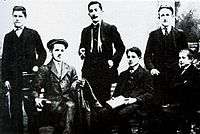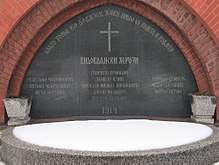Young Bosnia
Young Bosnia (Serbo-Croatian: Mlada Bosna/Млада Босна) was a revolutionary movement active in the Condominium of Bosnia and Herzegovina before World War I. The members were predominantly school students, primarily Bosnian Serbs (including Serb Muslims), but also Bosnian Muslims and Bosnian Croats. There were two key ideologies promoted amongst the members of the group, the Yugoslavist (unification into a Yugoslavia), and the Pan-Serb (unification into Serbia). Young Bosnia was inspired from a variety of ideas, movements, and events; such as German romanticism, anarchism, Russian revolutionary socialism, Fyodor Dostoyevsky, Friedrich Nietzsche, and the Battle of Kosovo.
Mlada Bosna | |
 Some of the members | |
| Formation | 1911 |
|---|---|
| Extinction | after 28 June 1914 |
| Type | Revolutionary organization |
| Purpose | Creation of Yugoslavia through unification of Bosnia and Herzegovina with Serbia |
Key people | Gavrilo Princip |
| Affiliations | Narodna Odbrana and Black Hand |
Background
The rise to power of the popular Karađorđević dynasty in Serbia in the 1900s after the May Overthrow of the Obrenović dynasty by the Serbian Army in 1903, stimulated support by both Serbs and South Slavs for their unification into a state led by Belgrade.[1] Support for revolutionary Yugoslavism in Bosnia grew with the rise of the Serbo-Croatian Progressive Organization in 1911, and drew in support for the cause from Serbs as well as Croats and some Bosniaks.[2] Bosniak members of the movement included Avdo Sumbul and Behdžet Mutevelić[3]
Formation, membership and ideology
It was formed during the 1900s in the Condominium of Bosnia and Herzegovina (an annexed condominium of Austria-Hungary), with significant influence from neighbouring Serbia.[4] The ideologue of Young Bosnia[5] and tyrannicide as its method of the political struggle, was Vladimir Gaćinović.[6] In one letter to Dedijer, one of revolutionaries from Herzegovina (Božidar Zečević) stated that the name of Young Bosnia was first mentioned by Petar Kočić in journal "Homeland" (Serbian: Отаџбина) in 1907; according to some sources Zečević was mistaken about the year of publication.[7] In 1911 Gaćinović published an article titled "Young Bosnia" in Almanac (Serbian: Алманах) published by Prosvjeta.[8] The Serbian National Organization of Petar Kočić had ties with the Young Bosnia.[9]
Young Bosnia received some assistance from the Black Hand – a secret organization founded by members of the Serbian Army.[2] On the other hand, Vladimir Gaćinović was the only Young Bosnia leader to join Black Hand,[10] although he condemned the assassination in a letter (presumably as a way to evade responsibility).[11]
The members were predominantly school students,[12] primarily Serbs but also Bosniaks and Croats.[13] There were several motivations promoted amongst different members of the group. There were members who promoted Yugoslavist aims of pan-South Slav unification of territories including Bosnia into a Yugoslavia.[14][15][9] There were members who promoted Serbian nationalist aims of pan-Serb unification into Serbia.[9] Young Bosnia was inspired from a variety of ideas, movements, and events; such as German romanticism, anarchism,[16] Russian revolutionary socialism, Fyodor Dostoyevsky, Friedrich Nietzsche, and the Battle of Kosovo.[2]
Assassination of Archduke Franz Ferdinand of Austria
Two notable organizations are referred to in connection with Young Bosnia: Narodna Odbrana and Black Hand. During a Serbian Court Martial in French-occupied Salonika in 1916–17, Chief of Serbian Military Intelligence Dragutin Dimitrijević Apis testified that he had organized the assassination of Archduke Franz Ferdinand of Austria, in Sarajevo on 28 June 1914, (the assassin was Gavrilo Princip). In the process, he used not only his power over elements of the Serbian military, but also the Black Hand. Leaders of the Black Hand in turn had penetrated Narodna Odbrana and used that organization to infiltrate the arms and assassins into Sarajevo.
"The political union of the Yugoslavs [..] was my basic idea [..] I am a Yugoslav nationalist, aiming for the unification of all Yugoslavs, and I do not care what form of state, but it must be free from Austria"
-Gavrilo Princip during his trial[9]

Claimed members of Young Bosnia who participated in the assassination were:
- Danilo Ilić (1891 – 3 February 1915)
- Veljko Čubrilović (1 July 1886 – 3 February 1915)
- Miško Jovanović (executed 3 February 1915)
- Nedeljko Čabrinović (2 February 1895 – 20 January 1916)
- Vladimir Gaćinović (25 May 1890 – 11 August 1917)
- Trifko Grabež (June 1895 – February 1916)
- Gavrilo Princip (25 July 1894 – 28 April 1918)
- Muhamed Mehmedbašić (1886 – 29 May 1943)
- Cvjetko Popović (1896 – 9 June 1980)
- Vaso Čubrilović (14 January 1897 – 11 June 1990)
An evening before the assassination of Archduke Franz Ferdinand, Princip, Čabrinović and Ilić visited the grave of Bogdan Žerajić for the last time.[17] Žerajić's proclamation "He who wants to live, let him die. He who wants to die, let him live", was quoted by Gavrilo Princip in one of the songs he wrote (Serbian: Ал право је рекао пре Жерајић, соко сиви: Ко хоће да живи, нек мре, Ко хоће да мре, нек живи).[18]
Legacy
Museum of Young Bosnia
The Museum of Young Bosnia was built in the period of SFR Yugoslavia in 1953, at the place where the assassination took place. It commemorates the assassins, popularly known in the Kingdom of Yugoslavia as the "Vidovdan heroes". At the front of the museum was a plaque, inscribed: "From this place, on 28 June 1914, Gavrilo Princip, expressed with his shot the people's revolt against tyranny and their centuries-old struggle for freedom. (Са овога мјеста 28. јуна 1914. године Гаврило Принцип својим пуцњем изрази народни протест против тираније и вјековну тежњу наших народа за слободом.)" In 1992, soldiers of the Army of the Republic of Bosnia and Herzegovina destroyed both the plaque and Princip's footprints. German forces had removed the 1930 plaque in 1941. The museum still exists today, but nowadays documents aspects of life in Bosnia & Herzegovina during Austro-Hungarian rule.
See also
References
- Djokić 2003, p. 59.
- Stevan K. Pavlowitch (2002). Serbia: The History of an Idea. New York University Press. pp. 90–91. ISBN 978-0-8147-6708-5.
- Jergović, Miljenko (5 January 2015). "Ulica Avde Sumbula". Radio Sarajevo. Radio Sarajevo. Retrieved 17 February 2019.
Obojica su bili aktivisti Gajreta, zaneseni srpskim pijemontizmom, mladobosanci i čisti idealisti
- John R. Lampe (28 March 2000). Yugoslavia as History: Twice There Was a Country. Cambridge University Press. pp. 90–. ISBN 978-0-521-77401-7.
- Belgrade (Serbia). Vojni muzej Jugoslovenske narodne armije (1968). Fourteen centuries of struggle for freedom. The Military Museum. p. II.
- Лесковац, Младен; Форишковић, Александар; Попов, Чедомир (2004). Српски биографски речник. Будућност. p. 634.
- Život. Svjetlost. 1989. p. 122.
И, подсећајући да му је то у писму са- општио Божидар Зечевић, наводећи погрешно 1907. годину...
- Dedijer 1966, p. 831.
- Banac 1988.
- Glenny, Misha (5 September 2012). The Balkans: Nationalism, War, and the Great Powers, 1804-2012: New and Updated. House of Anansi. ISBN 978-1-77089-274-3.
- Dedijer 1966, p. 522.
- Stevenson, David (2004). 1914 - 1918:The History of the First World War. Penguin Books. p. 11. ISBN 978-0-14-026817-1.
- Djokić 2003, p. 24.
- Neven Andjelic (2003). Bosnia-Herzegovina: The End of a Legacy. Psychology Press. ISBN 978-0-7146-5485-0.
- Matjaž Klemenčič, Mitja Žagar (2004). The Former Yugoslavia's Diverse Peoples: A Reference Sourcebook. ABC Clio. p. 56. ISBN 9781576072943.
- Trivo Indic (27 May 1990). "The anarchist tradition on Yugoslav soil". Umanità Nova. Retrieved 17 October 2014.
- Stand To!: The Journal of the Western Front Association. The Association. 2003. p. 44.
On the evening before 28 June 1914 Princip, Cabrinovic and Ilic paid a last visit to the grave of Bogdan Zerajic in Sarajevo. Zerajic had planned an assault ...
- Marković, Marko (1961). Članci i ogledi. p. 193.
Sources
- Banac, Ivo (1988). The National Question in Yugoslavia: Origins, History, Politics. Cornell University Press. ISBN 0-8014-9493-1.CS1 maint: ref=harv (link)
- Blakley, Patrick R. F. "Narodna Odbrana (The Black Hand): Terrorist Faction that Divided the World" (PDF). Oswego Historical Review. 2: 13–34.
- Bogićević, Vojislav (1954). Mlada Bosna: pisma i prilozi. Svjetlost.
- Dedijer, Vladimir (1966). Sarajevo 1914. Prosveta.CS1 maint: ref=harv (link)
- Djokić, Dejan (2003). Yugoslavism: Histories of a Failed Idea, 1918-1992. C. Hurst & Co. Publishers. ISBN 978-1-85065-663-0.CS1 maint: ref=harv (link)
- Ekmečić, Milorad (1964). Mlada Bosna. Musej grada.
- Gaćinović, Radoslav (2014). Mlada Bosna. ISBN 978-86-335-0416-4.
- Gaćinović, Radoslav (2014). "European Concept of the Young Bosnia Movement". Serbian Political Thought. 2: 51–67.
- Gilfond, Henry (1975). The Black Hand at Sarajevo. Bobbs-Merrill. ISBN 0672520702. OCLC 1692249.
- Imamović, Mustafa (2014). "The First Critical Approach to Young Bosnia". Prilozi. 43: 17–22.
- Jackson, Paul (2006). "'Union or Death!': Gavrilo Princip, Young Bosnia and the Role of 'Sacred Time' in the Dynamics of Nationalist Terrorism". Totalitarian Movements and Political Religions. 7 (1): 45–65. doi:10.1080/14690760500477935.
- Jevdjevic, D. (2002). Sarajevski zaverenici (in Serbian). Belgrade: Familet.
- Katz, Vera (2014). "Ideological use of Memorial Plaques dedicated to Gavrilo Princip in the upbringing and education of generations of youth in Bosnia and Herzegovina". Prilozi. 43: 99–111.
- Karajica, Tara (2014). "A Hero or a Villain, a Terrorist or a Liberator?". Heroism and Gender in War Films. Palgrave Macmillan: 35–47.
- Ljubibratić, Dragoslav (1964). Mlada Bosna i sarajevski atentat. Muzej grada Sarajeva.
- Masleša, Veselin; Đilas, Milovan (1945). Mlada Bosna. Kultura.
- Parežanin, Ratko (1974). Mlada Bosna i prvi svetski rat. Iskra.
- Turanjanin, Veljko M.; Čvorović, Dragana S. (2016). "Sarajevo 1914: Trial Process against Young Bosnia-Illusion of the Fair Process". Zbornik Radova. 50: 183–199. doi:10.5937/zrpfns50-11198.
Further reading
- Palavestra, Predrag (2010). "Young Bosnia: Literary action 1908-1914". Balcanica. 41: 155–184.
External links
| Wikimedia Commons has media related to Young Bosnia. |